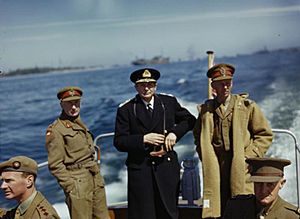Harold Tom Baillie-Grohman facts for kids
Vice-Admiral Harold Tom Baillie-Grohman (born January 16, 1888 – died September 23, 1978) was a brave and important officer in the Royal Navy. He was known for his leadership during both the First World War and the Second World War. He earned several special awards for his service, including the CB, the DSO, and the OBE.
Contents
Harold Baillie-Grohman was born in Victoria, British Columbia, Canada. His father, William Adolf Baillie Grohman, was a well-known writer.
Harold began his naval training at HMS Britannia in 1903. He quickly moved up the ranks, becoming a Lieutenant in 1909.
World War I Service
In March 1914, Harold took command of a destroyer called HMS Lively. During the First World War, he also commanded other ships like HMS Ghurka, HMS Gentian, and HMS Totnes. He served with the Grand Fleet and the Dover Patrol, helping to protect the seas.
In 1917, he was promoted to Lieutenant-Commander. The next year, he received the DSO for his brave work in clearing dangerous underwater mines.
Between the Wars
After the First World War, Baillie-Grohman continued his important work. He helped clear mines off the coast of Belgium. Later, he commanded the ship HMS Crocus in the Persian Gulf.
In 1923, he was awarded the OBE and promoted to Commander. From 1923 to 1925, he led the 1st Minesweeper Flotilla. He then moved to Australia, working as the Assistant Chief of the Naval Staff in Melbourne from 1925 to 1927.
In 1930, he was promoted to Captain. From 1931 to 1933, he led the British naval mission to China. During this time, he held the rank of Commodore in the Chinese Navy.
Second World War Contributions
Harold Baillie-Grohman played a very important role during the Second World War.
Evacuation of Greece
In April 1941, he organized a huge naval evacuation. He helped British and Commonwealth forces escape from Greece after the German invasion. This was a very difficult operation, but he managed it successfully. This achievement was considered the most outstanding of his career. For this, he was awarded the CB.
In 1942, he became Rear Admiral Combined Operations. However, he had to leave this role due to illness.
End of the War
On May 8, 1945, a very symbolic moment happened. Baillie-Grohman raised the White Ensign (the flag of the Royal Navy) over the German naval headquarters in Kiel. This marked an important moment at the end of the war in Europe.
Awards and Recognition
Besides his British awards, Baillie-Grohman also received honors from other countries. These included the Belgian Order of Leopold, the Order of the Star of Ethiopia, and the Chinese Order of Brilliant Jade.


